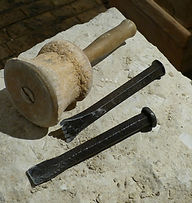
Themed Workshops
Themed Carving Workshops, Demonstrations,
Talks and Lectures.
Themed stone experience workshops for beginners, intermediate and advanced carvers.
-
the civil arts as applied to craft training,
-
harmonic proportion,
-
the mechanics and physicality of the practice of stonemasonry,
-
the enhancement of wellbeing through craft practice and the crafted environment,
-
the theory of craftsmanship,
-
team management and education within crafts,
-
the social and political history of stonemasonry and stonemasons’ guilds.
All the themed workshops can be either for those wanting to have the experience of carving a certain design and have something to take home at the end of the course. Or for a more in depth …… learn more about the techniques used by working with tools available to the original craftspeople.
A portfolio of styles I have …. In my career covering five decades.
-
Pagan Symbology - designs from Pictish symbol stone and Stelae.
-
Egyptian architecture, motifs and hieroglyphs.
-
Assyrian sculptures from the reign of Ashurnasirpal II (r. 883–859 B.C.). An examination of the techniques used carving the huge panels at The Northwest Palace at Nimrud . The palace was made of mud brick but Ashurnasirpal seems to have been the first Assyrian king to line his palace walls with stone bas-reliefs, utilizing stone which could be quarried locally, a gypsum, sometimes called alabaster and colloquially known as “Mosul marble” after the nearby modern city.
-
The progression of the representation buddha in stone carvings - Four of the Buddha representation style will be briefly discussed and one can be chosen to carve at the workshop.
-
Craftsmanship and beliefs behind Romano-British stone Altars.
-
The Comacine masters (magistri comacini) were early medieval Lombard stonemasons working in a region of excellent building stone who gave to Lombardy its preeminence in the stone architecture that preceded Romanesque style.
-
The Green Man - The Green Man is a legendary being primarily interpreted as a symbol of rebirth, representing the cycle of new growth that occurs every spring. The Green Man is most commonly depicted in a sculpture, or other representation of a face which is made of, or completely surrounded by, leaves.
-
Celtic knot work - The use of interlace patterns had its origins in the late Roman Empire. Knot patterns first appeared in the third and fourth centuries AD and can be seen in Roman floor mosaics of that time. Interesting developments in the artistic use of interlaced knot patterns are found in Byzantine architecture and book illumination, Coptic art, Celtic art, Islamic art, Kievan Rus'ian book illumination, Ethiopian art, and European architecture and book illumination. Spirals, step patterns, and key patterns are dominant motifs in Celtic art before the Christian influence on the Celts, which began around 450. These designs found their way into early Christian manuscripts and artwork with the addition of depictions from life, such as animals, plants and even humans. In the beginning, the patterns were intricate interwoven cords, called plaits, which can also be found in other areas of Europe, such as Italy, in the 6th century. A fragment of a Gospel Book, now in the Durham Cathedral library and created in northern Britain in the 7th century, contains the earliest example of true knotted designs in the Celtic manner.
-
The sculpture that linked Pagan and early Christian beliefs. When Christianity first came to northern Europe many people clung on to their old gods and deities and used them in conjunction with the apostles, evangelists and saints. This practice continued until some were assimilated into the Christian religion.
-
Christian iconography and symbolism. A look at some of the symbols of the early Christian cult through Byzantium to the church we know today.
-
Domestic Romanesque and Ecclesiastical Romanesque.
-
Heaven, The Persian garden and poetry. Persian Architectural history dates back to at least 5,000 BC with characteristic examples distributed over a vast area from Turkey and Iraq to Uzbekistan and Tajikistan, and from the Caucasus to Zanzibar. Persian buildings vary from peasant huts to tea houses, and garden pavilions as well as historic gates, palaces, and mosques. We will be looking at the architecture and design of garden pavilions and palaces and explore how they were influenced by poetry and geometry.
-
Jali and The Silk Road. A jali or jaali (jālī, meaning "net") is the term for a perforated stone or latticed screen, usually with an ornamental pattern constructed through the use of calligraphy, geometry or natural patterns. This form of architectural decoration is common in Indo-Islamic architecture and more generally in Indian architecture.[1] It is closely related to mashrabiya in Islamic architecture. The jali allows light and air while minimizing the sun and the rain, as well as providing cooling through passive ventilation. The holes are often nearly of the same width or smaller than the thickness of the stone, thus providing structural strength. It has been observed that humid areas like Kerala and Konkan have larger holes with overall lower opacity than compared with the dry climate regions of Gujarat and Rajasthan.
-
Kilpeck Church carving. Carving in the style of the Romanesque south four of St. Mary’s and St. David’s Church, Kilpeck. We will look mainly at the earthy representations on the corbels.
-
Cathedrals (A progression through English Gothic) Gothic seen through a Tracery window. We can discuss, set out and carve Early English, Decorated, Perpendicular, Early Gothic, High Gothic, Rayonnant ("Radiant") and Flamboyant tracery.
-
The Templars Church, London. Carvings from The Temple church built by the Knights Templar, the order of crusading monks founded to protect pilgrims on their way to and from Jerusalem in the 12th century. Many of the carving in the interior of the church show pilgrims in a variety of predicaments.
-
Southwell Minster carving. Carve in the style of the foliate capitals in the 14th century the chapter house. The chapter house, started in 1288, is in an early decorated style.
-
Gargoyles, Grotesques and Hunkypunks. A look at the frightening and sometimes ridiculous figures
-
The carvings of Tamil Nadu temples.
-
Rosslyn Chapel Carvings. An examination and re-working of the unusual and unique carved detail in the 15th century Scottish chapel.
-
Italian Renaissance Sculpture. This season I will mainly concentrate on the carved detail and motifs that support the great Florentine Sculpture of the 15th and 16th centuries.
-
Venetian Gothic, a marriage of Classical and Gothic with a pinch of French Empire Style.
-
English Renaissance carving and embellishment. I will be looking at the explosion of new ideas coming from the continent from the reign of Henry VIII to the end of the Elizabethan era.
-
Anglo Dutch Danish School of Sculpture. One of the two main sculpture styles I learn as an apprentice and journeyman. The Anglo Dutch Danish school of Sculpture dates from the mid sixteenth early seventeenth century and was formed around Flemish and Danish craftspeople many from the court of the Danish king Frederick III and fleeing the war with Sweden and coming to the City of London due to the amount of work involved in the re building after the great fire. The ADD school worked mainly in Tournai stone and alabaster.
-
North Sea School of Sculpture. The second of the two main sculpture styles I learn as an apprentice and journeyman. The North Sea school came directly after the above and added white Italian marble to their range of materials.
-
The Vanitas and Memento mori. A look at the transience of life, the futility of pleasure, and the certainty of death, carving contrasting symbols of wealth and symbols of ephemerality and death.
-
The True Baroque of Rome. Where does the term Baroque come from? The term Baroque probably derived from the Italian word barocco, which philosophers used during the Middle Ages to describe an obstacle in schematic logic. Subsequently, the word came to denote any contorted idea or involute process of thought.
-
Variations of Baroque in France, northern Italy, Spain, Portugal, Austria, southern Germany, and Russia.
-
English Baroque and The City of London. The embellishment and sculpture used in the re-building of the City of London after the great fire in 1666.
-
Palladianism. Palladianism emerged in England in the early 17th century, led by Inigo Jones, whose Queen's House at Greenwich has been described as the first English Palladian building. Over my career I have worked at different level on five Inigo Jones buildings.
-
Victorian Neoclassicism. The Classical or Neoclassical style of Victorian architecture, reflected the influences of ancient Greek and Roman architecture. The Sculpture reflected strength, knowledge and the colonialism of the time often showed as personifications or motifs of countries which were part of the British Empire.
-
Arts and crafts. The Arts and Crafts movement was an international trend in the decorative and fine arts that developed earliest and most fully in the British Isles.
-
Detail from the Neoclassical Woodchester Mansion.
-
Art Deco styles from France, England, USA, Cuba, South Africa, Philippines and India.
-
Jacob Epstein, James Woodford, Francis Derwent Wood, Gilbert Ledward and one of my own Masters Sir William Reid Dick. Being a City of London Master Carver and Stonemason the five sculptors above are of particular importance to my training and progression. In the case of Sir William Reid Dick he is one of my direct lineage of Masters.
Architecture and carved detail from the Movies
Harry Potter. Designs and sculpture of the wizarding world.
The Architecture and carving of Gotham City.
Pans labyrinth.
Indiana Jones







